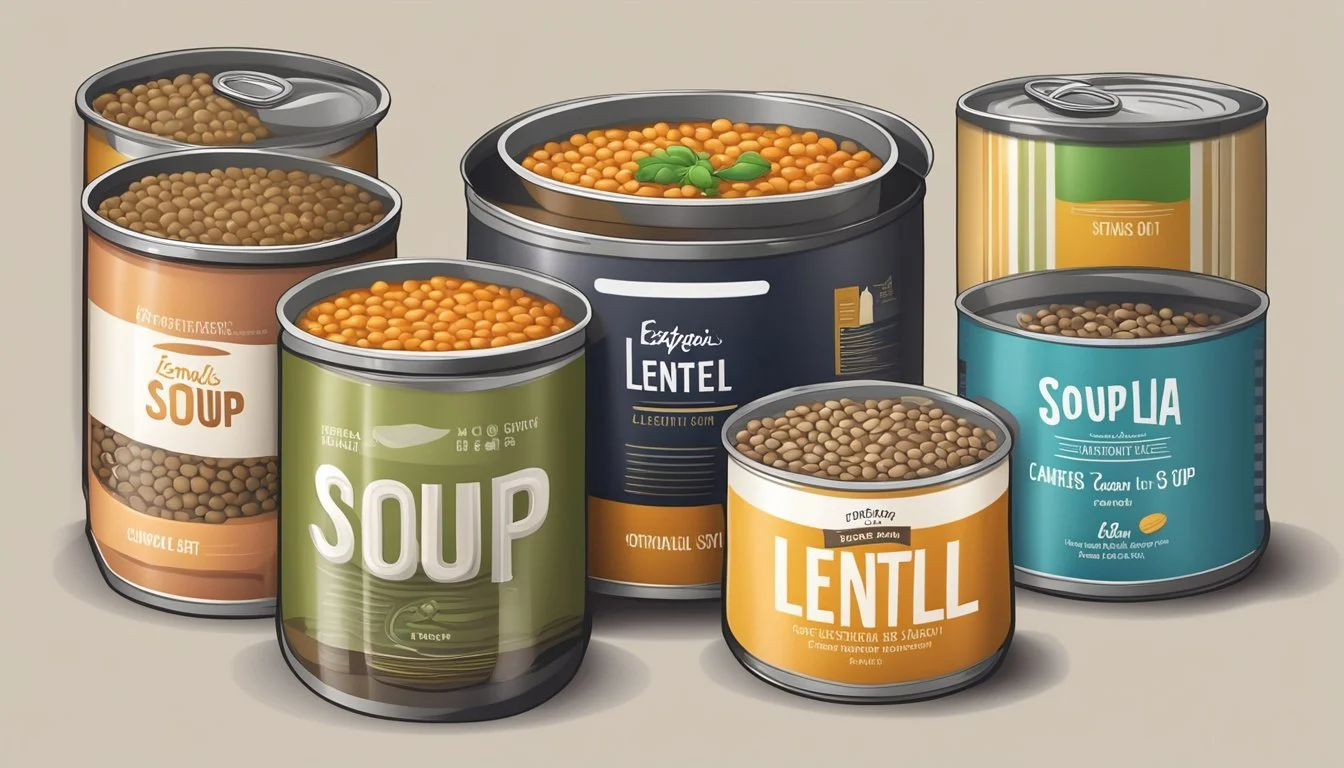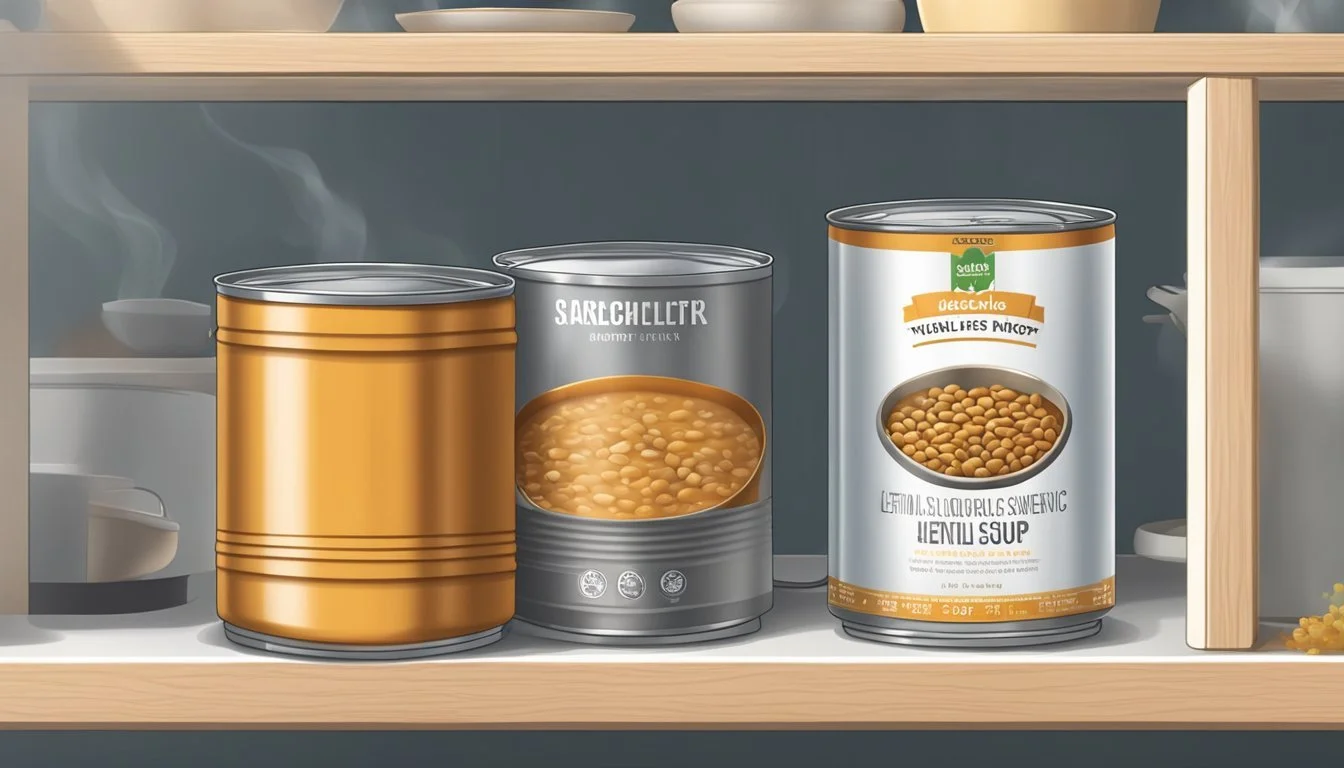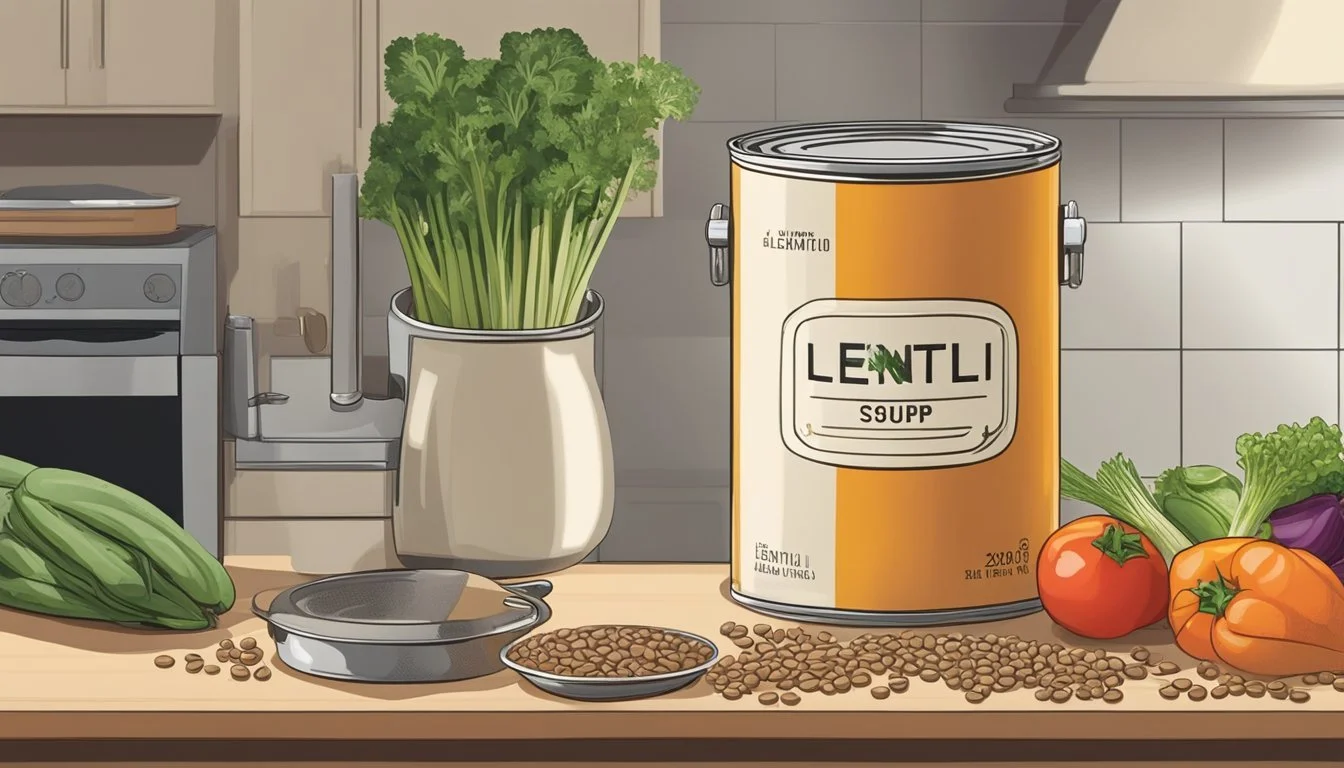Does Canned Lentil Soup Expire?
Shelf Life and Storage Tips
Canned lentil soup is a convenient and nutritious option for quick meals, but many consumers wonder about its shelf life and spoilage risks. An unopened can of lentil soup can generally stay at its best quality for about 3 to 5 years when stored properly in a cool, dry place. Even after this period, it often remains safe to consume as long as the can is undamaged and stored correctly.
Spoilage of canned lentil soup is rare due to airtight sealing and preservatives. Signs of spoilage include bulging cans, rust, leaks, or any off-smelling soup upon opening. Always inspect the can and its contents to ensure safety before consumption.
While the "best by" date on the can is a useful guideline for maximum quality, it is not a strict expiration date. Consumers can often enjoy canned lentil soup well beyond this timeframe, ensuring it remains a reliable pantry staple for extended periods.
Understanding Food Expiration Dates
Expiration dates on food packaging can be confusing. They include terms like expiration date, best by, best before, best if used by, and best when used by. Each term indicates different aspects of food safety and quality.
Expiration date: Indicates the last date the manufacturer guarantees the product is safe to consume. After this date, the product's safety can no longer be assured.
Best by/best before: Suggests when the product will be at its peak quality. The food may still be safe to eat after this date, but its quality might decline.
Best if used by/best when used by: Provides a recommendation for when the product will have the best flavor or quality. It is not a safety date.
These dates are often based on the manufacturer's estimate of how long the product will maintain its best quality. Proper storage conditions can extend a product's shelf life beyond these dates.
Canned foods, including lentil soup, are sealed in airtight containers and can last years if stored correctly. A cool, dry place with temperatures between 50°F and 70°F is ideal.
Lists of common terms:
Expiration Date: Last day guaranteed safe
Best by/Before: Peak quality date
Best if/when Used By: Optimal flavor/quality date
Paying attention to these terms helps ensure food safety and optimal quality.
The Shelf Life of Canned Lentil Soup
Canned lentil soup is a convenient and long-lasting pantry staple. The shelf life of this product can vary significantly depending on whether the can is unopened, has been opened, or has been frozen for extended preservation.
Unopened Cans
Unopened cans of lentil soup can have a very long shelf life. Properly stored, they can maintain their best quality for 3 to 5 years. Storage methods are crucial; these cans should be kept in a cool, dry place to prevent any degradation of the soup.
To further maximize the shelf life, avoid exposing the cans to extreme temperatures, which can compromise the sealed packaging. Consistent storage conditions help ensure the soup remains safe and palatable for an extended period.
After Opening
Once opened, canned lentil soup has a significantly shorter shelf life. Transfer any remaining soup to a covered glass or plastic container and refrigerate promptly to extend its usability. In the refrigerator, the soup can last for about 3 to 4 days.
After this period, the risk of spoilage increases, and the soup should be discarded to avoid potential foodborne illnesses. Following these storage guidelines ensures that the soup maintains its quality and safety after the can has been opened.
Extending Shelf Life Through Freezing
Freezing is an effective way to prolong the shelf life of canned lentil soup after opening. To do this, transfer the soup to freezer-safe containers and ensure they are sealed tightly. Frozen, the soup can last 3 to 4 months without significant loss of quality.
When ready to use, thaw the soup in the refrigerator overnight or use a microwave on the defrost setting. Freezing provides a practical solution for enjoying canned lentil soup over a more extended period without worrying about spoilage.
Proper Storage Conditions
Proper storage conditions are crucial to extend the shelf life of canned lentil soup and ensure its quality. Adhering to specific guidelines can help maintain the soup's taste and safety for extended periods.
The Role of Temperature
Temperature control is essential. Canned lentil soup should be stored at room temperature, ideally a cool, dry place where the temperature remains steady. Fluctuations in temperature can affect the soup's quality and longevity.
Avoid heat sources. Storing the cans away from direct sunlight, stoves, and other heat sources helps maintain an optimal internal temperature. High temperatures can cause the contents' flavor and texture to degrade faster.
Refrigeration and freezing. If the soup has been opened, it should be transferred to an airtight container and refrigerated. Consuming it within 3-4 days is optimal. For longer-term storage, freezing is viable. Ensure the internal temperature reaches or maintains at least 40°F to preserve its quality and safety.
Airtight Containers and Preservation
Use airtight containers. Once opened, transferring lentil soup to an airtight container is essential. This minimizes exposure to air, which can lead to bacterial growth and spoilage. Airtight containers preserve the soup's freshness and prevent contamination.
Commercially packaged benefits. The airtight nature of commercially packaged lentil soup contributes to its long shelf life. These containers are designed to keep out air and moisture, protecting the soup for up to 1-2 years, provided they remain unopened.
Storage guidelines post-opening. Following proper storage guidelines post-opening is necessary to maintain quality. Storing in a cool place and ensuring the container is airtight will help keep the soup safe for consumption longer.
Identifying Spoilage in Canned Lentil Soup
Identifying spoilage in canned lentil soup is crucial to ensure food safety. Key indicators include visual and textural changes, alterations in odor and flavor, and the integrity of the can itself.
Visual and Textural Changes
Changes in the appearance and texture of canned lentil soup are important indicators of spoilage. Discoloration such as darkening or the presence of unusual colors can signal bacterial contamination. Mold growth on the surface or inside the can is a clear sign that the soup has gone bad and should be discarded immediately.
The texture can also provide clues. If the soup has an unusual or slimy texture, it should not be consumed. It's important to inspect the contents closely for any changes that might indicate spoilage.
Odor and Flavor
Alterations in smell and taste are strong indicators of spoilage in canned lentil soup. A sour or unpleasant odor often suggests bacterial contamination and spoilage. The soup should have a neutral or slightly savory smell, typical of lentils and seasoning.
Flavor changes are equally telling. An off or sour taste indicates spoilage, and the soup should be discarded immediately. Always trust your senses—if something doesn't smell or taste right, it's better not to consume it.
Can Integrity
The can’s physical condition is another critical factor in determining the safety of the lentil soup. Leaking, rusting, or severely dented cans can compromise the contents and promote bacterial growth. Significant bulging of the can may indicate gas production from harmful bacteria and is a sure sign the soup is spoiled.
Inspect the can for any damage before opening. Ensure the can is intact and stored properly to prevent contamination. Maintaining can integrity is essential for the longevity and safety of the contents within.
Food Safety Considerations
Ensuring the safety of canned lentil soup involves careful attention to preventing bacterial growth and proper reheating techniques to avoid foodborne illness.
Preventing Bacterial Growth
Preventing bacterial growth in canned lentil soup starts with proper storage. Canned foods should be stored in a cool, dark place, maintaining a consistent temperature between 50°F and 70°F. Extremes in temperature can compromise the can's integrity, leading to bacterial contamination.
Always inspect cans for dents, rust, or bulging, which are signs of potential bacterial contamination. Once opened, transfer unused soup to an airtight container and refrigerate it immediately.
Refrigerated lentil soup should be consumed within 3-4 days. To extend its shelf life, consider freezing portions, which can maintain quality for up to three months. Proper labeling with dates ensures safe use and prevents the risk of consuming expired soup.
Reheating and Foodborne Illness
Proper reheating is crucial to prevent foodborne illness. Lentil soup should be reheated to an internal temperature of 165°F to ensure any harmful bacteria are destroyed. Using a microwave or a pot on the stove are both effective methods.
When using a microwave, stir the soup multiple times to ensure even heating. Uneven heating can leave cold spots where bacteria can survive. A food thermometer is handy for confirming the correct temperature.
Avoid cross-contamination by using clean utensils and surfaces. Leftover soup should not be reheated more than once. Each reheating cycle increases the risk of bacterial growth, making the soup less safe to eat.
Adhering to these guidelines ensures that canned lentil soup remains safe and delicious to consume.
Nutritional Value and Benefits
Canned lentil soup offers significant nutritional benefits. Rich in plant-based protein, it provides a substantial alternative for those reducing meat consumption. Typically, a serving of lentil soup can contain about 11 grams of protein, supporting muscle repair and growth.
Fiber is another key component. Lentils are known for their high fiber content, aiding in digestion and promoting a feeling of fullness. A serving of lentil soup often contains around 2 grams of fiber.
The soup is also a good source of various vitamins and minerals. Essential nutrients such as iron, folate, and magnesium are abundant, contributing to overall health. These nutrients support various functions, including energy production and immune function.
Canned lentil soup includes a mix of ingredients like vegetables and seasonings. These additions can increase the nutrient profile, offering vitamins A and C from vegetables, vital for immune health and skin integrity.
Here's a nutritional breakdown for a typical serving:
Nutrient Quantity Protein 11g Fiber 2g Iron 20% DV Folate 15% DV Magnesium 10% DV
The enjoyment of lentil soup isn't just in its taste but also in its nutritional benefits. Many find passion in creating variations, enhancing both flavor and nutrient content by adding fresh vegetables and diverse seasonings. This adaptability makes lentil soup a valuable addition to a balanced diet.
Options Beyond Disposal
When dealing with canned lentil soup that is past its expiration date, disposal is not the only option. There are several creative ways to use older lentil soup, and methods to assess its suitability for consumption.
Creative Culinary Uses of Older Lentil Soup
Older lentil soup can still be a valuable ingredient in your kitchen. Lentil curry is a popular choice; the spices blend well with lentils, enhancing their flavor even if they are not at their peak quality.
Another idea is to use leftover lentil soup as a base for a stew. Adding fresh vegetables, potatoes, or even some meat can transform it into a hearty meal.
Lentil soup can also be repurposed into a filling for savory pastries. Using older lentil soup creatively means less waste and more nutritious meals.
Assessing Suitability for Consumption
Before repurposing expired lentil soup, it's crucial to assess whether it is still safe to consume. Check the can for any signs of damage, like dents, rust, or bulging, which could indicate spoilage.
Smell and taste tests are also important. If the soup has an off odor or unusual taste, it is best to discard it.
Note the storage conditions as well. Lentil soup stored in a cool, dry place is more likely to retain its best quality longer.
Make sure to heat the soup thoroughly before consuming to ensure any potential bacteria are killed. Always prioritize safety when dealing with expired foods.
Types and Varieties of Lentils
Lentils come in various types and forms, each with unique characteristics suited to specific dishes.
Dry Lentils
Dry lentils are the most common form found in pantries. They need to be rinsed and then cooked before consumption. They typically have a long shelf life when stored in a cool, dry place.
Canned Lentils
Canned lentils are pre-cooked and convenient for quick meals. They can be kept unopened for several years. Once opened, they should be stored in an airtight container and refrigerated.
Dried Lentils
Similar to dry lentils, dried lentils require cooking. They are often preferred for long-term storage because of their durability.
Split Lentils
Split lentils have their hulls removed and are split in half. This allows them to cook faster, making them ideal for quick soups and stews. They do not hold their shape as well as whole lentils.
Cooked Lentils
Cooked lentils, whether from a can or cooked from dry state, are versatile and ready to be added to various dishes. They can be used in soups, salads, and even as a protein-rich base for main courses.
Common Types
Brown Lentils: Earthy flavor, hold shape well.
Green Lentils: Firm texture, peppery taste.
Red Lentils: Soft texture, sweet flavor; often used in Indian dishes.
Black Lentils: Small, robust lentils known for their rich, earthy flavor.
Freezing and Thawing Processes
Freezing and thawing lentil soup can help extend its shelf life and maintain quality. Understanding specific methods can optimize preservation and ensure the soup retains its flavor and texture.
Methods of Freezing Lentil Soup
To properly freeze lentil soup, it should first be cooled to room temperature. Freezing cooked lentils ensures that their texture remains intact during storage. Using freezer bags or airtight containers helps prevent freezer burn.
When using freezer bags, place the bag inside a bowl and fold over the top to allow it to stand. Ladle the soup into the bag, filling only halfway to allow for expansion. After squeezing out excess air, seal the bag tightly. For best results, label each bag with the date to keep track of the soup’s age.
Thawing and Reheating Frozen Lentil Soup
Thawing lentil soup is best done in the refrigerator overnight to maintain its safety and quality. Once thawed, it can be reheated on the stovetop over medium heat, stirring occasionally to ensure even heating.
For quicker reheating, the microwave can be used. Transfer the soup to a microwave-safe container, cover it loosely, and heat in short intervals, stirring in between. Leftover lentil soup from previous meals should also be reheated to an internal temperature of 165°F to ensure it is safe to eat.
By adhering to these techniques, lentil soup can be preserved effectively, making it a convenient option for future meals.
Lentil Soup Preparation and Usage Tips
Preparation: Making homemade lentil soup involves selecting fresh ingredients. Start by sorting and rinsing the lentils to remove any debris. Cooking lentils typically takes 20-30 minutes. Add vegetables, broth, and spices according to your recipe.
Different types of lentil soup include vegetarian, meat-based, and spiced variations like curry or Mediterranean. Each type brings unique flavors and nutritional benefits.
Storage Method: Proper storage is crucial to extend the soup's shelf life. Refrigerate homemade lentil soup in covered glass or plastic containers. It can last in the refrigerator for up to 3-4 days.
For longer storage, consider freezing the soup. Place it in airtight containers or heavy-duty freezer bags, leaving some space for expansion. Lentil soup can remain in the freezer for up to 3 months.
Reheating: When reheating lentil soup, ensure it reaches an internal temperature of 165°F (74°C). This practice helps kill any bacterial growth that may have occurred during storage.
Usage Tips: Always check for signs of spoilage before consuming leftover soup. Discard any soup with unusual odors, colors, or textures. For canned lentil soup, follow the manufacturer's instructions for optimal use and shelf life. Unopened cans stored in a cool, dry place maintain quality for 3-5 years.
Canned Lentil Soup: Once opened, transfer any leftover soup to a covered container and refrigerate. Consume within 3-4 days to maintain safety and flavor.
Conclusion
Canned lentil soup has a notably long shelf life, often remaining at its best quality for 3 to 5 years. Proper storage conditions, including keeping cans in a cool, dark place, contribute to this extended preservation.
Quality may decline after the expiration date. However, as long as the can is undamaged and stored correctly, the soup is usually safe to consume.
Key Points:
Shelf Life: 3-5 years (best quality)
Storage: Cool, dark place, consistent temperature (50°F-70°F)
For optimal food safety, always check the can for damage or bulging before consuming expired soup.
Reheat any leftovers to an internal temperature of 165°F (74°C) to ensure safety. Properly handled canned lentil soup can be a delicious and convenient meal option.







